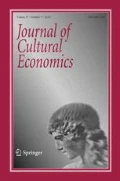Abstract
The legitimation of technology policy is discussed from the point of view of the neoclassical and of the dynamic, Schumpeterian, approach. The results are presented, using the traditional categories of policy legitimation in welfare theory: public goods, externalities, and merit goods. Art policy legitimation is discussed within the same conceptual framework. The application of the dynamic approach to art policy leads to conclusions similar to the general conclusions about technology policy. A review of the postwar development of (Dutch) art policy supports the impression that art policy may be on its way to become a subspecies of technology policy.
Similar content being viewed by others
References
Abbing, H.R. (1980) ‘On the Rationale of Public Support to the Arts: Externalities in the Arts Revisited’, in W.S. Hendon (ed.)Economic Policy for the Arts. Cambridge Mass., pp. 34–42.
Abbing H.R. (1989)Een Economie van de Kunsten. Groningen: Historische Uitgeverij Groningen.
Arrow, K. (1961) ‘Economic Welfare and the Allocation of Resources to Innovation’, in R.R. Nelson (ed.)The Rate and Direction of Inventive Activity. Princeton: Princeton University Press, pp. 619–622.
Derain, J.C. (1990)America's Struggle for Leadership in Technology. Paris: Albin Michel.
Duijn, J.J. van (1983)The Long Wave in Economic Life. London: Geogre Allen & Unwin.
Freeman, C., J. Clark, and L. Soete (1982)Unemployment and Technical Innovation. London: Francis Pinter.
Fullerton, D. (1991) ‘On Justification for Public Support of the Arts’,Journal of Cultural Economics 15, 67–82.
Gombrich, E.H. (1982)The Story of Art. Oxford: Phaidon Press.
Grampp, W.D. (1989)Pricing the Priceless. New York: Basic Books.
Hall, P.H. (1986) ‘The Theory and Practice of Innovation Policy: An Overview’, in P.H. Hall (ed.)Technology, Innovation and Public Policy. Oxford: Phillip Allan, pp. 1–34.
Hietbrink, S., F. van Puffelen, and J.A.M. Wesseling (1985)De Economische Betekenis van de Profesionele Kunsten in Amsterdam. Amsterdam: Stichting voor Economisch Onderzoek.
Kabel, J.J.C. (1991) ‘Beeldende Kunst en Auteursrecht’, inKunst en Beleid in Nederland, vol. 5. Amsterdam: Boekmanstichting/Van Gennep, pp. 67–124.
Kleinknecht, A. (1986)Innovation Patterns in Crisis and Prosperity. London: MacMillan.
Levin, R.C. (1988) ‘Appropriability, R&D spending and technological performance’,American Economic Review 78, 424–428.
Mansfield, E. (1985) ‘How Rapidly does New Industrial Technology Leak Out?’,Journal of Industrial Economics 34, 217–223.
Mansfield, E., J. Rapoport, A. Romeo, E. Villani, S. Wagner, and F. Husic (1977)The Production and Application of New Industrial Technology. New York: Norton.
Martorella, R. (1990)Corporate Art. New Brunswick: Rutgers University Press.
Mowery D.C. and N. Rosenberg (1990)Technology and the Pursuit of Economic Growth. Cambridge: Cambridge University Press.
Myerscough, J. (1988)The Economic Importance of the Arts in Britain. London: Policy Studies Institute.
Nelson, R.R. and S.G. Winter (1982)An Evolutionary Theory of Economic Change. Cambridge Mass.: Harvard University Press.
Ng, Y.-K. (1979)Welfare Economics. London: MacMillan.
Oosterbaan Martinius, W. (1990)Schoonheid, Welzijn, Kwaliteit: Kunstbeleid en Verantwoording na 1945. Den Haag: Gary Schwartz/SDU.
Peacock, A. (1991) ‘Economics, Cultural Values and Cultural Policies’,Journal of Cultural Economics 15, 1–18.
Radich, A.J. (ed.) (1987)The Economic Impact of the Arts. Washington D.C.: National Conference of State Legislatures.
Rostow, W.W. (1960)The Stages of Economic Growth. New York.
Rostow, W.W. (1978)The World Economy. Methuen: London.
Scherer, F.M. (1980)Industrial Market Structure and Economic Performance. Chicago: Rand McNally.
Scherer, F.M. (1984)Innovation and Growth. Cambridge Mass.: MIT Press.
Scitovsky, T. (1972) ‘What's Wrong with the Arts is What's Wrong with Society’,American Economic Review 62, 67–82.
Solow, R.M. (1957) ‘Technical Change and the Aggregate Production Function’,Review of Economics and Statistics 39, 312–320.
Ungern-Sternberg, Th. von (1984) ‘Innovator Protection and the Rate of Technical Progress’,Journal of Economic Behaviour and Organization 5, 115–129.
Wijnberg, N.M. (1990)Innovation, Competition and Small Enterprises. Alblasserdam: Haveka.
Woude, A.M. van der (1991) ‘De Schilderijproduktie in Holland tijdens de Republiek’, in J.C. Dagevos, P.H. van Druenen, P.Th. van der Laar and P.R.A. Oeij (eds.)Kunstzaken. Kampen: Kok Agora, pp. 18–51.
Author information
Authors and Affiliations
Rights and permissions
About this article
Cite this article
Wijnberg, N.M. Art and technology: A comparative study of policy legitimation. J Cult Econ 18, 3–13 (1994). https://doi.org/10.1007/BF01207149
Issue Date:
DOI: https://doi.org/10.1007/BF01207149



